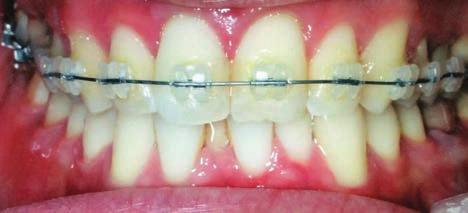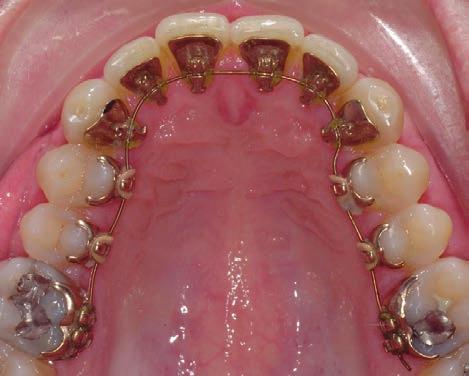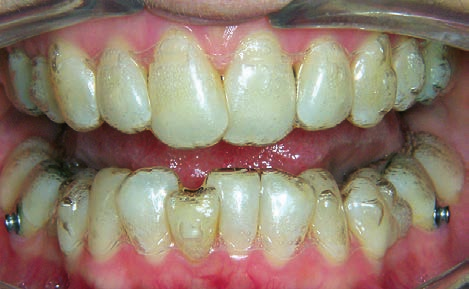If you are thinking about having orthodontic treatment as an adult you
might have some questions you would like to ask your orthodontist.
What might I gain from orthodontic treatment?
The benefits of orthodontic treatment can
include the following:
- Improving your appearance, including your smile.
- Correction of dental crowding and straightening of your teeth.
- Correction of your bite so the front and back teeth meet together evenly on closing.
- To aid other dental treatment.
Age is not a limiting factor although the types of treatment may be different in adults.
Where teeth have not developed or are missing, braces can be used to close gaps between the teeth
or create space for false teeth to be placed. One of the following may then be fitted if space is created:
- Dental bridge (resin bonded bridge) - a false tooth glued onto another tooth.
- Dental implant - a false tooth on a titanium screw put into the jaw bone.
How visible are the braces?

Tooth coloured brace

Lingual brace

Aligner
Fixed braces are available in tooth coloured varieties that blend in with the natural colour
of teeth. The wires used to straighten teeth can also be coated with a tooth coloured
material to make them less visible. Some tooth coloured braces are not placed on the
bottom teeth as they can cause wear to the top teeth.
It is also possible to have braces glued to the
back of your teeth (lingual braces). These are
much less visible but can be more noticeable
to the tongue and cause changes to speech
initially.
Aligners are clear, removable ‘mouthguards’
which fit closely over teeth. A series of aligners
is used to straighten teeth. They are worn day
and night to achieve the best outcome but
should be removed to eat and drink. They
are often used with tooth-coloured/ metal
attachments fixed to the teeth.
Is it always possible to have braces as an adult?
Yes, however, certain problems in adults cannot
be corrected with braces alone and may require
a combination of jaw surgery and orthodontics.
If you have tooth decay or gum disease, it is very
important to treat this before braces are fitted.
Will I need teeth removed?
If space is needed to straighten teeth or correct
the bite, teeth may need to be removed. In
certain situations teeth can be narrowed down
in width (interproximal reduction). A detailed
assessment with planning is always needed.
How long will treatment take?
Simple straightening can sometimes be
carried out in less than 12 months, however
more difficult problems can take longer. A
short course of treatment can give limited
changes. Retainers must be worn to hold the
teeth once the braces are finished in order to
stop the teeth moving back.
Will it be painful?
Your teeth are likely to be sore for about 3 - 5
days each time the brace is adjusted. If
necessary, simple painkillers can be taken
to help - please read the instructions on the
packet. If the brace rubs your lips or cheeks,
you can use some orthodontic relief wax to
help with this. Your orthodontist can give you
further advice. Protective shields, to be worn
at night, can be supplied with lingual braces
to help protect the tongue.
How often will I need an appointment?
Once the brace has been fitted, you will need
regular appointments for it to be adjusted.
Do I still need to see my regular dentist?
Yes. It will be important that you still
have check-ups with your regular dentist
throughout orthodontic treatment so that
your teeth can be checked for tooth decay
and gum disease.
Will I need to wear another brace once treatment has finished?
You will need to wear a retainer once your
brace treatment finishes. Retainers are fixed
(glued onto the back of your front teeth)
and/or removable. Your orthodontist will
advise you what will work best for you.
How long will I need to wear the retainer?
You will be advised to wear your retainer
regularly for as long as you wish your teeth to
remain straight. Changes in the position of
your teeth can continue throughout life and
are part of the normal ageing process.
The only way to have permanently straight
teeth is to wear a retainer on a part-time
basis for life.
How much will it cost?
This depends on the difficulty of your case
and the type of brace used.
REMEMBER
- You can have braces at any age.
- Your teeth and gums need to be healthy
before orthodontic treatment is started
and need to be maintained in a healthy
state throughout treatment.
- Some complex problems in adults
cannot be treated with braces alone.
- A variety of brace types are available.
Further information:-
Copyright© BOS 2019 British Orthodontic Society 12 Bridewell Place London EC4V 6AP


